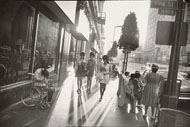 |
 |
 |
 |
Grades/Level: Middle School (6–8), High School (9–12)
Subjects: Visual Arts, English–Language Arts, ESL
Time Required: 2–Part Lesson
Two 50-minute class periods
Author: J. Paul Getty Museum Education Staff
|
 |
|
 |
 |
 |
 |
 |
 |
 |
Lesson Overview |
 |
Students will examine a photograph and participate in a class discussion about their own experiences living in the urban landscape. They will create a collage from magazines that reflect life in the city as they have experienced it. They will then write about their collage of the city. |
 |
 |
 |
 |
 |
Learning Objectives |
 |
Students will be able to:
• use English–language vocabulary to describe what they see in a work of art.
• create a collage that communicates their experience of the urban environment.
• write about their collage, articulating what they were trying to express through visual images using English–language vocabulary.
|
 |
 |
 |
 |
 |
 |
 |
 |
 |
Materials |
 |
• Reproduction of Hollywood Boulevard by Garry Winogrand
• Background Information about Hollywood Boulevard
• Magazines, newspapers
• Scissors
• Glue
• 9 x 12–inch construction paper
|
 |
 |
 |
 |
 |
|
|
 |
 |
 |
 |
 |
Lesson Steps |
 |
1. Display and introduce the reproduction of Hollywood Boulevard by Garry Winogrand, making sure to cover the title. Refer to the Background Information about Hollywood Boulevard for more information.
2. Begin a class discussion about Garry Winogrand's Hollywood Boulevard by using the following questions:
• What do you see in this picture?
• What words would you use to describe this place? Explain to students that this is a scene in Hollywood.
• Have you ever visited Hollywood? If so, compare what you experienced there to what you see in the photograph.
• What evidence of nature do you find in this image?
• What is the interaction of the people in the photograph?
• Is this similar or different from the city or town that you know? In what way?
3. Tell students that they are going to create their own urban scene by making a collage using newspapers and magazines. Have them look for images that reflect their own personal experiences of the city, and then cut them out and combine them in an image on a sheet of 9 x 12–inch construction paper.
4. Once they have completed their collages, ask students to write about their own artworks, describing the image and what they chose to include. Ask students to compare and contrast the subjects of the images in their collage with the subjects in the images in the photograph. The writing activity can be varied, based upon each student's English–language developmental (ELD) level.
5. Have students orally present their collage to the class, either by reading what they wrote about their collage or by just describing what they created.
|
 |
 |
 |
| Hollywood Boulevard, Garry Winogrand, 1969, © 1984. The Estate of Garry Winogrand
|
 |
|
 |
 |
 |
 |
 |
 |
 |
Assessment |
 |
Students will be assessed based on their:
• participation in class discussion.
• completion of the collage assignment.
• ability—dependent on their ELD level—to write about their works of art.
|
 |
 |
 |
 |
 |
Extensions |
 |
For beginning-level students, as a class, create a simple narrative about their experiences in the city. Have students examine the photograph Hollywood Boulevard and think about what they would see, smell, hear, taste, and feel if they were in the photograph. Ask them to think of simple phrases to fill in the blanks of the poem.
In the city...
I see ________________________________________________.
I smell _______________________________________________.
I hear _______________________________________________.
I taste _______________________________________________.
I touch/feel ___________________________________________.
Students may also pick one character in the photo, and then write from the point of view of that character.
|
 |
 |
 |
 |
 |
 |
 |
 |
 |
Standards Addressed |
 |
Common Core Standards for English Language Arts
Grades 6–12
WRITING
Text Types and Purposes
2. Write informative/explanatory texts to examine and convey complex ideas and information clearly and accurately through the effective selection, organization, and analysis of content.
Production and Distribution of Writing
4. Produce clear and coherent writing in which the development, organization, and style are appropriate to task, purpose, and audience.
SPEAKING AND LISTENING
Comprehension and Collaboration
1. Prepare for and participate effectively in a range of conversations and collaborations with diverse partners, building on others' ideas and expressing their own clearly and persuasively.
2. Integrate and evaluate information presented in diverse media and formats, including visually, quantitatively, and orally.
Presentation of Knowledge and Ideas
4. Present information, findings, and supporting evidence such that listeners can follow the line of reasoning and the organization, development, and style are appropriate to task, purpose, and audience.
|
 |

|
 |
 |
 |


